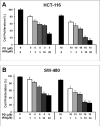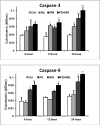Caspase-mediated pro-apoptotic interaction of panaxadiol and irinotecan in human colorectal cancer cells
- PMID: 22471369
- PMCID: PMC3349342
- DOI: 10.1111/j.2042-7158.2012.01463.x
Caspase-mediated pro-apoptotic interaction of panaxadiol and irinotecan in human colorectal cancer cells
Abstract
Objectives: Panaxadiol is a purified sapogenin of ginseng saponins that exhibits anticancer activity. Irinotecan is a second-line anticancer drug, but clinical treatment with irinotecan is limited due to its side effects. In this study, we have investigated the possible synergistic anticancer effects of panaxadiol and irinotecan on human colorectal cancer cells and explored the potential role of apoptosis in their synergistic activity.
Key findings: The combination of panaxadiol and irinotecan significantly enhanced antiproliferative effects in HCT-116 cells (P< 0.05). Cell cycle analysis demonstrated that combining irinotecan treatment with panaxadiol significantly increased the G1-phase fractions of cells, compared with irinotecan treatment alone. In apoptotic assays, the combination of panaxadiol and irinotecan significantly increased the percentage of apoptotic cells compared with irinotecan alone (P<0.01). Increased activity of caspase-3 and caspase-9 was observed after treating with panaxadiol and irinotecan. The synergistic apoptotic effects were supported by docking analysis, which demonstrated that panaxadiol and irinotecan bound two different chains of the caspase-3 protein.
Conclusions: Data from this study suggested that caspase-3- and caspase-9-mediated apoptosis may play an important role in the panaxadiol enhanced antiproliferative effects of irinotecan on human colorectal cancer cells.
© 2012 The Authors. JPP © 2012 Royal Pharmaceutical Society.
Figures






Similar articles
-
Letter to the editor: Panaxadiol's anticancer activity is enhanced by epicatechin.Am J Chin Med. 2010;38(6):1233-5. doi: 10.1142/S0192415X10008597. Am J Chin Med. 2010. PMID: 21061473
-
Panaxadiol, a purified ginseng component, enhances the anti-cancer effects of 5-fluorouracil in human colorectal cancer cells.Cancer Chemother Pharmacol. 2009 Nov;64(6):1097-104. doi: 10.1007/s00280-009-0966-0. Epub 2009 Mar 11. Cancer Chemother Pharmacol. 2009. PMID: 19277659
-
The synergistic apoptotic interaction of panaxadiol and epigallocatechin gallate in human colorectal cancer cells.Phytother Res. 2013 Feb;27(2):272-7. doi: 10.1002/ptr.4707. Epub 2012 May 8. Phytother Res. 2013. PMID: 22566066 Free PMC article.
-
Dammarane-type leads panaxadiol and protopanaxadiol for drug discovery: Biological activity and structural modification.Eur J Med Chem. 2020 Mar 1;189:112087. doi: 10.1016/j.ejmech.2020.112087. Epub 2020 Jan 25. Eur J Med Chem. 2020. PMID: 32007667 Review.
-
Anti-Colorectal Cancer Activity of Panax and Its Active Components, Ginsenosides: A Review.Int J Mol Sci. 2025 Mar 13;26(6):2593. doi: 10.3390/ijms26062593. Int J Mol Sci. 2025. PMID: 40141242 Free PMC article. Review.
Cited by
-
Anticancer Activity of Saponins from Allium chinense against the B16 Melanoma and 4T1 Breast Carcinoma Cell.Evid Based Complement Alternat Med. 2015;2015:725023. doi: 10.1155/2015/725023. Epub 2015 Jun 3. Evid Based Complement Alternat Med. 2015. PMID: 26146506 Free PMC article.
-
Role of Ginseng, Quercetin, and Tea in Enhancing Chemotherapeutic Efficacy of Colorectal Cancer.Front Med (Lausanne). 2022 Jun 20;9:939424. doi: 10.3389/fmed.2022.939424. eCollection 2022. Front Med (Lausanne). 2022. PMID: 35795631 Free PMC article. Review.
-
Synthesis, characterization and cytotoxic activity evaluation of ginsengdiol oxidation and nitrogen hybrid derivatives.Medchemcomm. 2018 Oct 18;9(11):1910-1919. doi: 10.1039/c8md00387d. eCollection 2018 Nov 1. Medchemcomm. 2018. PMID: 30568759 Free PMC article.
-
Effects of ginseng on two main sex steroid hormone receptors: estrogen and androgen receptors.J Ginseng Res. 2017 Apr;41(2):215-221. doi: 10.1016/j.jgr.2016.08.005. Epub 2016 Aug 23. J Ginseng Res. 2017. PMID: 28413327 Free PMC article. Review.
-
Anticancer Activities of Protopanaxadiol- and Protopanaxatriol-Type Ginsenosides and Their Metabolites.Evid Based Complement Alternat Med. 2016;2016:5738694. doi: 10.1155/2016/5738694. Epub 2016 Jun 30. Evid Based Complement Alternat Med. 2016. PMID: 27446225 Free PMC article. Review.
References
-
- Jemal A, et al. Cancer statistics, 2010. CA Cancer J Clin. 2010;60:277–300. doi: 10.3322/caac.20073. - PubMed
-
- Hawk ET, Levin B. Colorectal cancer prevention. J Clin Oncol. 2005;23:378–391. doi: 10.1200/JCO.2005.08.097. - PubMed
-
- Yao Y, et al. Combined chemotherapy of hydroxycampothecin with oxaliplatin as an adjuvant treatment for human colorectal cancer. Tohoku J Exp Med. 2008;215:267–278. doi: 10.1620/tjem/215.267. - PubMed
-
- Patel BB, et al. Curcumin enhances the effects of 5-fluorouracil and oxaliplatin in mediating growth inhibition of colon cancer cells by modulating EGFR and IGF-1R. Int J Cancer. 2008;122:267–273. doi: 10.1002/ijc.23097. - PubMed
-
- Politano S, et al. Second-line chemotherapy use in metastatic colon cancer varies by disease responsiveness. Clin Colorectal Cancer. 2008;7:55–59. doi: 10.3816/CCC.2008.n.008. - PubMed
Publication types
MeSH terms
Substances
Grants and funding
LinkOut - more resources
Full Text Sources
Medical
Research Materials

